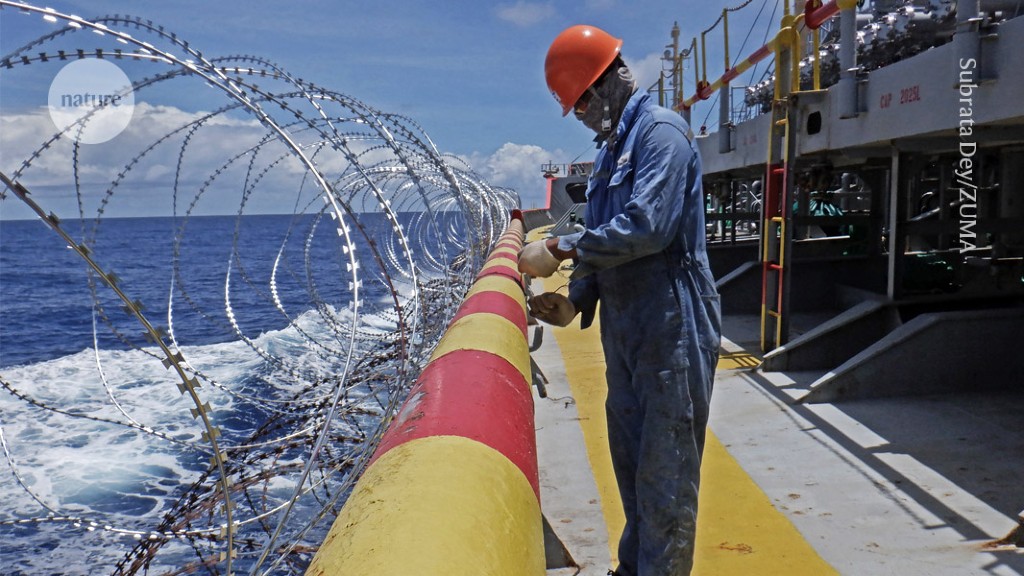Piracy at sea is waning — but hotspots remain

A greater understanding of pirate attacks can help to inform the development of countermeasures

Cargo ships use barbed wire to protect against pirates.Credit: Subrata Dey/ZUMA
Pirate attacks on the high seas are on the decline — and have been for around a decade — according to researchers who analysed thousands of attacks worldwide over a 15-year period.
Piracy costs the global economy an estimated US$25 billion every year. Most of it is the work of small, opportunistic groups operating in just a few hotspots around the globe, the authors report in a study published on 12 December in Ocean and Coastal Management1. Since peaking in 2011, the number of reported pirate attacks has dropped to its lowest point in more than a decade.
Understanding where, why and how pirates are most likely to strike can help companies to protect ships that are travelling through dangerous waters, says Jessica Di Salvatore, a political scientist at the University of Warwick, UK. “If we know that some routes are more risky, then one can prepare for that by having more security and surveillance in place.”
Source: Ref. 1
Ocean shipping is responsible for moving up to 90% of all internationally traded goods. But every year, dozens of ships come under attack from pirates: bands of maritime marauders that attempt to board ships moving through international waters to seize goods or hold crew members for ransom.
In the 1980s and 1990s, institutions such as the International Maritime Organization (IMO) began keeping databases tracking attacks. Back then, most pirate raids happened to ships moving through southeast Asia.
Records show that piracy experienced a renaissance in the mid-2000s, when many ships off the coast of northeast Africa came under attack from people travelling in small boats. In 2008 alone, 815 people from 42 ships were taken hostage in the region, and some of them were held for years. A pirate raid is “an exceptionally distressing experience” for the seafarers involved, says Andrew Clarke, a technical officer for maritime security at the IMO.
This spike in piracy in a commercially significant area — where many ships are moving to and from the Suez Canal — created a renewed interest in understanding what modern piracy looks like. Many studies focused on regional and global trends in piracy. To gain further insight, researchers at the Shanghai Maritime University in China and their colleagues used data from the IMO database and analysed more than 4,000 attacks that occurred between 2006 and 2021.
Source: Ref. 1
The researchers found that global piracy spiked in about 2011 — peaking at around 500 attacks a year (see ‘Attacks in decline’). Understanding exactly why this happened isn’t simple, says Clarke. A rise in civil conflict and famine, as well as the economic turmoil resulting from the 2008 economic crisis, might have pushed people in Somalia and surrounding regions into a life of crime, the study’s authors say.
The drop in piracy rates since 2011 — reaching a low of just 131 incidents in 2022, down from 172 the year before — has been driven in large part by renewed stability in that region, says Di Salvatore. “Piracy happens offshore,” she says. “But its causes and effects are tightly intertwined with onshore conditions.”
Preventive measures
Knowing where pirates strike — and what those attacks look like — can help people to prepare for travel through international waters, says Clarke. For instance, the study found that 87% of attacks are carried out by crews of fewer than ten people, with 55.3% of pirate crews carrying nothing more than knives or machetes.
This is in line with reports that many attacks are opportunistic, with pirates looking to quickly grab goods and leave, says Clarke. Countermeasures such as keeping watch while at anchor, securing the ship with barbed wire and deploying water guns are all options for fending off these small strikes.
But pirates operating in some regions aren’t as easily foiled. Attacks in the Gulf of Guinea — an area off the coast of west Africa that has experienced frequent piracy (see ‘Piracy hotspots’) — tend to involve larger crews armed with guns who are more likely to use violence, says Di Salvatore. To discourage this activity, an international armada of ships patrolled the waters off the coast of Somalia between 2009 and 2016.
There is more to maintaining the overall decrease in piracy than equipping ships to fend off individual attacks, says Clarke. Policies and programmes that support legitimate industries such as fishing in countries where piracy is a problem have helped to prevent crews coming under attack. The downward trend in piracy seems to be holding, he says, with the Indian Ocean officially revoked as an area of high risk for piracy as of January 2023. But, he says, “we are very careful to guard against complacency”.
doi: https://doi.org/10.1038/d41586-024-00124-6
This story originally appeared on: Nature - Author:Freda Kreier


















